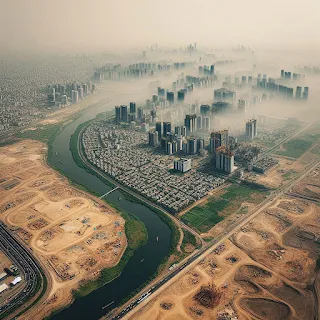India's urban landscape is undergoing a massive transformation. Real estate development is surging, driving economic activity and infrastructure growth. However, this rapid urbanization comes at a cost. As cities sprawl into floodplains and regions vulnerable to heatwaves, climate risks are intensifying. Between 2021 and 2023, India spent over US$ 300 million on flood mitigation alone—highlighting a pressing need to rethink urban planning through a climate-resilient lens.
The Real Estate Boom: Growth at What Cost?
-
India’s cities are among the fastest-growing in the world.
-
Real estate and infrastructure projects are seen as engines of economic development.
-
However, many of these projects are expanding into ecologically fragile areas such as wetlands, floodplains, and forest buffers.
-
These actions disrupt natural water drainage, amplify urban heat islands, and destroy climate buffers.
Flooding and Heatwaves: Symptoms of Poor Urban Planning
-
Cities like Chennai, Bengaluru, and Delhi have experienced intense urban floods due to encroachments on water bodies.
-
Heatwaves in cities such as Ahmedabad and Nagpur are becoming longer and deadlier due to concrete-centric development with minimal green cover.
-
The National Disaster Management Authority (NDMA) reports that floods have caused nearly US$ 300 million in losses over just two years.
The Climate Cost of Urban Sprawl
-
Loss of natural ecosystems reduces a city’s ability to adapt to extreme weather.
-
Expansion into floodplains and low-lying areas increases disaster vulnerability.
-
Buildings and roads replace trees and grass, trapping heat and reducing urban ventilation.
-
Water scarcity worsens as groundwater is depleted and natural recharge zones vanish.
The Role of Policy and Governance
-
India lacks a national framework for climate-resilient urban planning.
-
Municipalities often prioritize short-term development goals over long-term sustainability.
-
Environmental Impact Assessments (EIAs) are frequently bypassed or diluted.
-
Existing master plans often do not factor in climate change adaptation or disaster risk management.
Solutions: Building Climate-Resilient Cities
1. Enforce Zoning Laws and Restore Natural Buffers
-
Prohibit construction in floodplains and ecologically sensitive areas.
-
Encourage wetland and mangrove restoration within urban limits.
2. Invest in Green Infrastructure
-
Develop green roofs, urban forests, and permeable pavements.
-
Incorporate blue-green corridors to manage stormwater and cool cities.
3. Climate-Integrated Urban Master Plans
-
Embed climate risk assessments into city development plans.
-
Encourage community participation and localized climate actions.
4. Leverage Technology for Smart Urban Planning
-
Use GIS and AI to monitor land use, climate exposure, and flood risk.
-
Promote data-driven decision-making for infrastructure development.
Conclusion
India's urban future hinges not just on growth, but on sustainable, climate-conscious growth. If cities continue expanding without considering ecological and climate factors, economic gains will be quickly eroded by disasters. By integrating resilience, nature, and people into urban planning, India can shape cities that thrive even in the face of a changing climate.


No comments:
Post a Comment